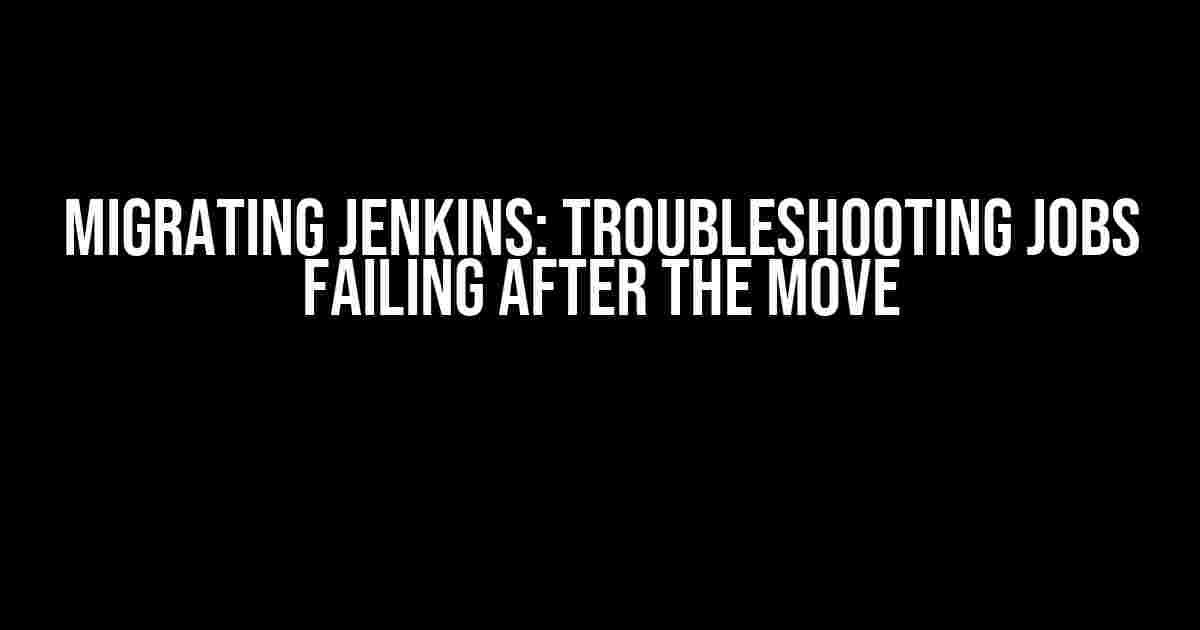Migrating Jenkins to a new server or environment can be a daunting task, especially when your jobs start failing after the move. Don’t worry, you’re not alone! In this article, we’ll guide you through the common issues that might occur and provide step-by-step solutions to get your Jenkins jobs up and running smoothly again.
Pre-Migration Checklist
Before we dive into troubleshooting, let’s make sure you’ve completed the essential pre-migration tasks:
Backup your Jenkins configuration and datausing the built-in backup feature or a plugin likejenkins-backup.Verify plugin compatibilitywith the new Jenkins version, if you’re upgrading.Update your Jenkins configuration files, such asjenkins.xmlandhudson.model.ParametersDefinitionProperty.xml, to reflect the new environment.Test your Jenkins installationon the new server or environment before migrating your jobs.
Common Issues Causing Job Failures
Now that we’ve got the pre-migration tasks covered, let’s explore the common issues that might cause job failures after migrating Jenkins:
1. Plugin Incompatibility
If you’ve upgraded your Jenkins version during the migration, plugin incompatibility might be the culprit. Check the plugin compatibility matrix to ensure you’re using compatible versions.
$ jenkins-plugin-manager --list-incompatible-plugins
This command will list any incompatible plugins. Update or remove them accordingly.
2. Environment Variables and Configurations
Environment variables, such as JENKINS_HOME, JAVA_HOME, or custom variables, might not be set correctly in the new environment. Double-check your environment configurations and update them as needed.
$ echo $JENKINS_HOME
This command will display the current value of the JENKINS_HOME environment variable.
3. Job Configuration anddependencies
Job configurations, such as SVN or Git repository settings, might not have been transferred correctly during the migration. Review your job configurations and update them as necessary.
$ jenkins-job-dump --job=my_job > job_config.xml
This command will dump the job configuration to an XML file, which you can review and update manually.
4. Missing or Incorrect Dependencies
Dependent plugins or libraries might not have been installed or configured correctly in the new environment. Ensure all necessary dependencies are installed and configured.
$ jenkins-plugin-manager --install plugin_name
This command will install the specified plugin.
5. Permissions and Access Control
Permissions and access control settings might not have been transferred correctly during the migration. Review your permissions and update them as necessary to ensure the correct users and groups have access to your Jenkins jobs.
$ jenkins-permission-manager --list-permissions
This command will list the current permissions and access control settings.
Troubleshooting Steps
Now that we’ve identified the common issues, let’s walk through the step-by-step troubleshooting process:
Verify the Jenkins logsfor any error messages or exceptions that might indicate the cause of the job failure.Check the job configurationand dependencies to ensure everything is correctly set up.Verify environment variables and configurationsare set correctly.Check for plugin incompatibilityand update or remove incompatible plugins.Review permissions and access control settingsto ensure the correct users and groups have access to your Jenkins jobs.Test the job againto see if the issue is resolved.
Best Practices for Migrating Jenkins
To avoid job failures after migrating Jenkins, follow these best practices:
| Best Practice | Description |
|---|---|
| Test before migrate | Test your Jenkins installation on the new server or environment before migrating your jobs. |
| Use automated backups | Use automated backup plugins or scripts to ensure your Jenkins configuration and data are backed up regularly. |
| Verify plugin compatibility | Verify plugin compatibility with the new Jenkins version before migrating. |
| Document environment configurations | Document your environment configurations, such as environment variables and permissions, to ensure they’re correctly set up in the new environment. |
| Migrate in stages | Migrate your Jenkins jobs in stages, starting with the most critical ones, to minimize downtime and identify any issues early on. |
Conclusion
Migrating Jenkins can be a complex process, but by following the best practices and troubleshooting steps outlined in this article, you’ll be well-equipped to handle any job failures that might occur after the move. Remember to stay calm, methodically work through the troubleshooting process, and don’t hesitate to seek help if you need it.
Happy migrating!
Frequently Asked Question
Jenkins migration got you down? Don’t worry, we’ve got the answers to get your jobs up and running again!
Why are my Jenkins jobs failing after migration?
This is often due to differences in the plugin configurations or version incompatibilities between the old and new Jenkins instances. Check the plugin versions and configurations to ensure they match, and test your jobs again.
How do I troubleshoot job failures after Jenkins migration?
Start by checking the Jenkins logs for error messages, then review the job’s configuration and plugin versions. You can also try re-running the job with increased logging verbosity to identify the issue.
What’s the best approach to testing Jenkins jobs after migration?
Test your jobs in a staging environment before migrating to production. Start with a small set of jobs and gradually add more, monitoring the results and addressing any issues that arise.
Will my Jenkins plugins work after migration?
It depends on the plugin versions and compatibility. Check the plugin documentation and test them after migration to ensure they work as expected. You may need to update or replace incompatible plugins.
How can I minimize downtime during Jenkins migration?
Plan ahead, test thoroughly, and perform the migration during a maintenance window. Use a rolling update or blue-green deployment strategy to minimize downtime and ensure a seamless transition.
I hope this helps!


